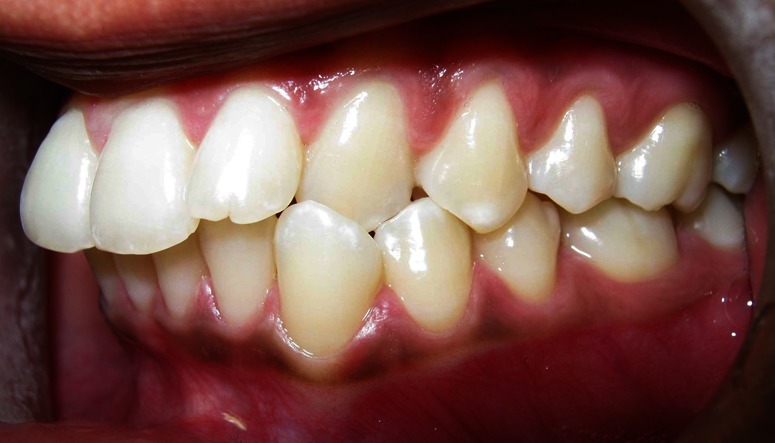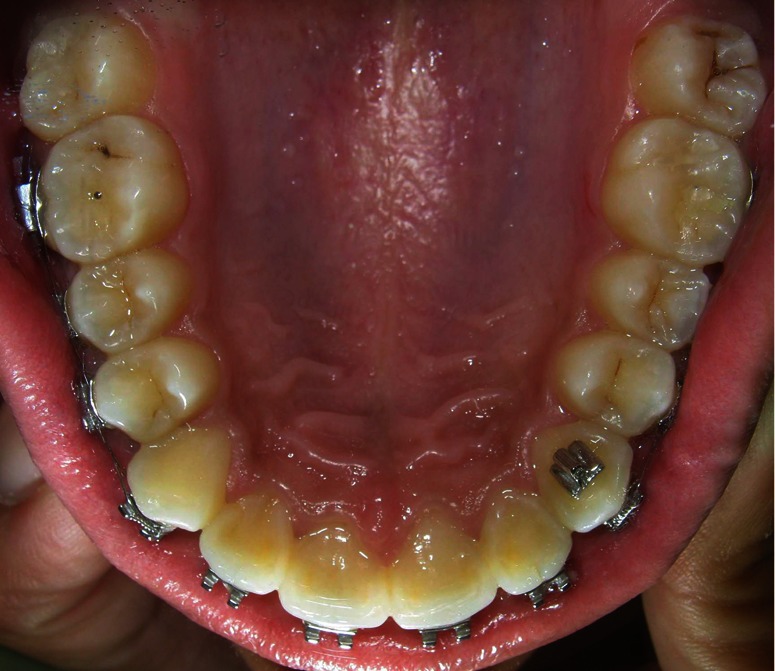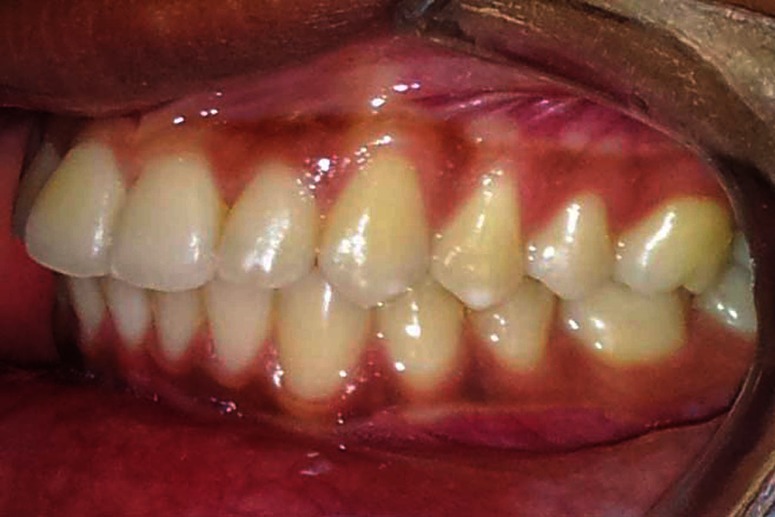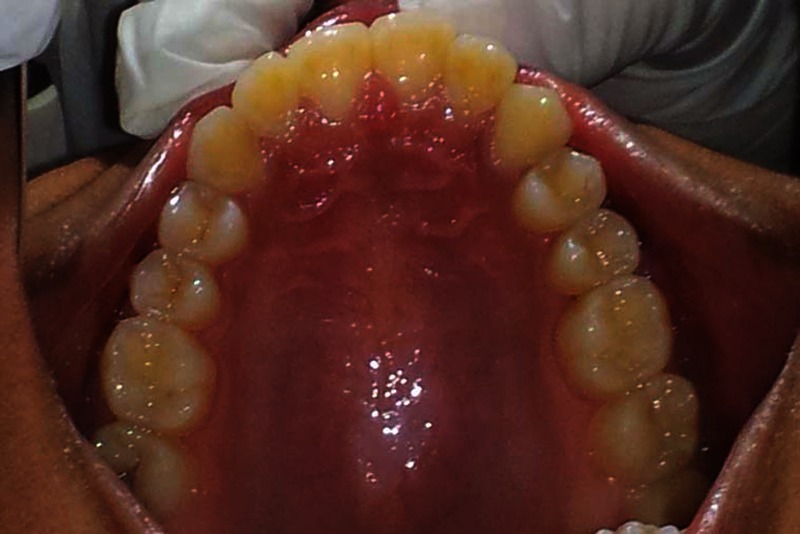Abstract
In cases of anterior crossbite we need to disocclude the bite so as to initiate unrestricted pathway for the teeth to come into the arch. Various techniques have been advocated for this purpose but most of them are either costly, time consuming or not very effective. So, by the use of simple bondable Begg bracket and elastics we devised a method to disocclude the bite and help in correction of anterior crossbite. It is easy, economical, efficient and less time consuming.
Background
Anterior crossbite is defined as a malocclusion resulting from the lingual positioning of the maxillary anterior teeth in relationship to the mandibular anterior teeth.1 Various treatment methods have been proposed to correct anterior dental crossbite, such as tongue blades, reversed stainless steel crowns, fixed acrylic planes, bonded resin-composite slopes and removable acrylic appliances with finger springs.2–5 Bite planes are very uncomfortable to the patients. Some patients may not be able to tolerate fixed or removable bite planes.
A simple and effective method of treating anterior single crossbites has been used.
Case presentation
A 19-year-old female patient with Class I skeletal and Angle's class I molar relationship with 3 mm of crossbite in relation to upper left maxillary canine.
Treatment
A 19-year-old female patient reported with 3 mm of crossbite in relation to upper left maxillary canine. The pretreatment photograph of the patient is shown in figure 1. A Begg bracket is bonded to the lingual surface of the canine, and 5/16” elastic is inserted from this Begg bracket across the incisal edge encircling the arch wire with coil spring and engaged back into Begg bracket (figures 2 and 3). The canine in crossbite did not have enough space to move labially. Hence space is gained by placing an open-coil spring between the lateral incisor and the canine. The patient was instructed how to engage the elastic and change it daily for 3 weeks. The elastic will intrude the incisor while moving it labially. The elastic used during this procedure acted as bite plane. Although this labial movement is pure tipping, once the crown has been moved the rectangular arch wire can be engaged in the canine bracket for torquing. It took 1 month to move the canine crown labially. The crossbite correction was observed in 3 weeks time interval (figures 4 and 5). There was no retention given as crossbite is a self-retaining malocclusion. The patient was on follow-up and even after 2 years of active orthodontic treatment there were no signs of relapse (figures 6 and 7) suggesting a good stability of results.
Figure 1.

Pre-treatment photograph showing crossbite of left maxillary canine.
Figure 2.

Occlusal view of the patient showing lingually bonded ‘Begg bracket’ engaging 5/16” elastic passing incisally crossing over the wire and open-coil spring and engaged back into Begg bracket.
Figure 3.

5/16” elastic crossing over the wire and open-coil spring.
Figure 4.

Correction of crossbite of maxillary left canine within 3 weeks of time interval.
Figure 5.

Occlusal view after correction of crossbite.
Figure 6.

Stability of correction after 2 years of active treatment.
Figure 7.

Occlusal view after 2 years of active treatment.
Outcome and follow-up
The follow-up was done till 2 years of removal of appliance and there was no sign of relapse and a good and functional occlusion was present.
Discussion
Since most of the lingually erupted teeth do not have enough space to move labially, an open-coil spring has been used to create space for the tooth in crossbite. A Begg bracket was bonded lingually to the tooth in crossbite and a 5/16″ elastic was engaged from Begg bracket passing occlusally encircling over the wire, open-coil spring and again engaged back into Begg bracket lingually. The elastic applied a force of 3.5 ounce. The elastics used acted as bite plate and this method efficiently corrected crossbite without the use of bite plates.
This appliance has proven to be easy and effective in correcting anterior crossbites and thus avoiding occlusal interferences without the use of bite planes.
Learning points.
Compressed open-coil spring can be used between two teeth to create space between them.
Beggs bracket can be used as an lingual attachment.
Elastics from lingual to buccal on the same teeth can be used to disocclude the bite.
Footnotes
Competing interests: None.
Patient consent: Obtained.
Provenance and peer review: Not commissioned; externally peer reviewed.
References
- 1.Tsai H. Components of anterior crossbite in the primary dentition. ASDC J Dent Child 2001;2013:27–32 [PubMed] [Google Scholar]
- 2.Olsen CB. Anterior cross bite correction in uncooperative or disabled children. Case reports. Aust Dent J 1996;2013:304–9 [DOI] [PubMed] [Google Scholar]
- 3.Valentine F, Howitt JW. Implications of early anterior cross bite correction. J Dent Child 1970;2013:420–7 [PubMed] [Google Scholar]
- 4.Deam JA, McDonald RE, Avery DR. Managing the developing occlusion. In: McDonald RE, ed. Dentistry for the child and adolescent. 7th edn London: Mosby, 2000:677–741 [Google Scholar]
- 5.Vadiakas G, Viazis AD. Anterior crossbite correction in the early deciduous dentition. Am J Orthod Dentofacial Orthop 1992;2013:160–2 [DOI] [PubMed] [Google Scholar]


